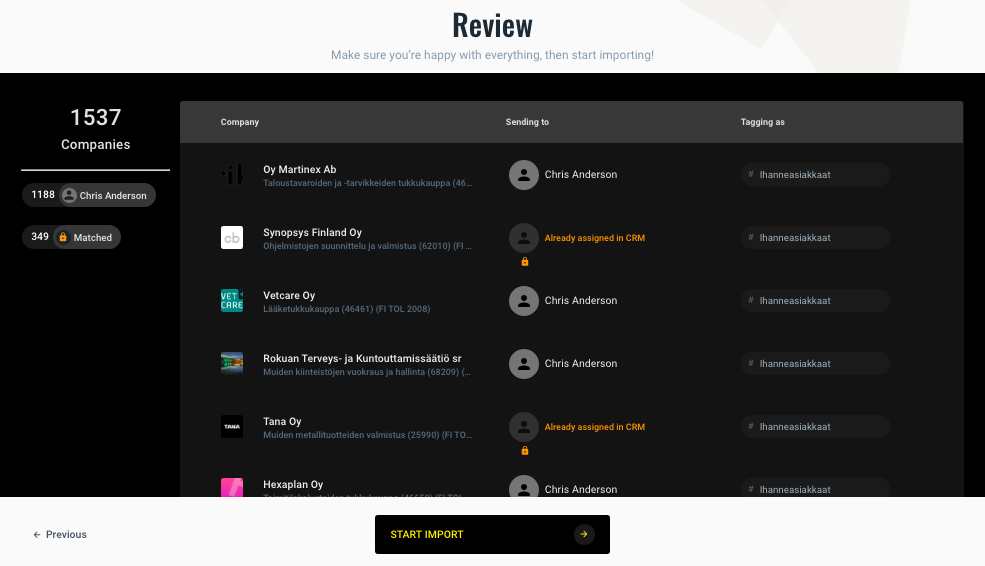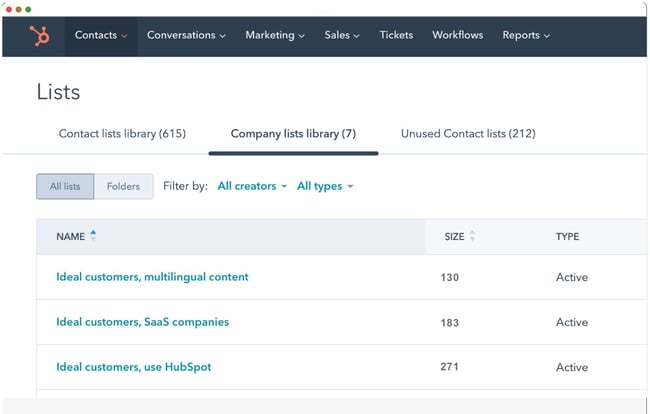Customer Segmentation: Driving Sales With Targeted Marketing
It’s well documented that target marketing campaigns, like account-based marketing (ABM), deliver better results and higher return on investment. The rationale is very straightforward. ABM concentrates most resources on the highest-value prospective customers possible, using highly targeted, personalized campaigns to win over particular accounts.
As attractive as it sounds, ABM might not be worth your time without the right setup. And, that includes heavy reliance on data. In this article, we’re going to see how you can segment your target audience and create small account clusters so you can drive sales with targeted marketing.
Let’s get into it.
This article is included in our practical guide The Beginner's Handbook to Account-Based Marketing. Go to this page to download the whole eBook.
The most common pitfall with account-based marketing
Account-based marketing is a strategy that uses data to create lists of target accounts. Not enough data points—or too many of them— can ruin an ABM campaign before it takes off.
Knowing how to choose the target account is undoubtedly a significant challenge. A poorly executed ABM program will leave it to marketers as ABM is often seen as one more marketing tactic. When marketers pick the list of target accounts in isolation, they might not have access to all the necessary data on the accounts. Often, they just rely on their most used tool, such as a marketing automation platform. The opposite case—an abundance of data— is also typical. A CRM full of unstructured and old data can leave marketers overwhelmed with data points and noise.
For an ABM strategy to work, sales and marketing have to be aligned. For both departments to work in sync, it’s important they share goals, terminology, and have a crystal-clear understanding of the company’s ideal customers. More importantly, data integration through a shared tech stack will glue the functions together. (Don’t forget to establish an explicit sales and marketing service level agreement ahead of time to avoid issues down the line.)
Such a setup paves the way for targeted marketing campaigns and tactics like ABM. Let’s see next how to execute them.
Know your target groups
Successful ABM campaigns start with marketing working alongside sales to develop lists that reflect their company’s ideal customer profile. The goal of ABM is personalized sales and marketing, but you can’t reach personalization at scale without finding common attributes among your targets.
As such, one of the key success factors for an ABM program is the specificity of your target account lists. Unfortunately, if you’re solely relying on basic firmographic data points, you might notice that you’re not always able to find the companies you’re looking for. This is especially true if you’re trying to approach a specific vertical that is not part of a national or international standard industry classification system. Vainu's AI-based industry classification system solves this issue. If you want to find out how Vainu Custom Industries can help your account-based marketing campaigns, we've got the article for you—read it here.
Let’s take one company as an example. We’ll call it Happy Pencil because they’re a content marketing agency that produces anything from blog posts to videos and podcasts. Happy Pencil offers Content as a Service and looks for customers ready to pay a monthly fee for content production.
Happy Pencil’s ideal customer profile is:
- Companies operating in Scandinavia that have a turnover of over 5 million euros and that invest in digital marketing content and measure performance in data-driven ways with adequate technology.
So far, so good. That’s enough criteria to search for prospects. Using Vainu’s prospecting features, we find the right search options:
- Industry: all but the public sector
- Revenue: €5M - €500M
- Use a marketing automation platform
- On their websites, they offer blog posts, newsletters, guides, or e-books

With such criteria, we end up with a list of 1,537 companies matching Happy Pencil’s description of the ideal customer profile. Some of these companies are already in the CRM (349), but most are not (1,188). With a tightly integrated tech stack, exporting this list of companies to a CRM or a marketing automation platform is just a matter of a few clicks.
Once we’ve identified our initial list of target accounts, we will further segment the audience into smaller account clusters that allow the degree of personalization ABM requires.
Creating customer segments for targeted marketing
A large segment of 1,537 accounts is suitable for one-to-many ABM campaigns. This approach allows you to personalize outreach lightly, but to get more granular and develop one-to-one and one-to-few ABM campaigns, you want to create even smaller segments or account clusters that have similar company characteristics or attributes. With smaller account lists, marketing and sales can build highly customized campaigns and scale them using technology.
Once we’ve identified our initial list of target accounts, we will further segment the audience into smaller account clusters that allow the degree of personalization ABM requires.
Back to our example, we can determine smaller segments among Happy Pencil’s ideal customers:
- Companies that use video content
- Companies that produce podcasts
- Companies that use HubSpot
- SaaS companies
- Potential face-to-face meetings
- Companies that publish content in several languages
With additional criteria, we run a new search in Vainu to build smaller target lists. To identify international companies, we look for company websites translated into different languages. To find companies with good potential face-to-face meetings, we search for companies located within 50km. And to find companies that use HubSpot or podcast, we look into the technologies companies use.
The result of this search is a set of new target lists. Some of the accounts might belong to one or more lists.
- Use video content: 849 companies, 55% of ICP accounts
- Produce podcasts: 77 companies, 5% of ICP accounts
- Use HubSpot: 271 companies, 18% of ICP accounts
- SaaS companies: 183 companies, 12% of ICP accounts
- Potential face-to-face meetings: 835 companies, 54% of ICP accounts
- Publish content in several languages: 130 companies, 8% of ICP accounts
Import segments into your CRM and marketing automation platforms
The next step is to put those segments into work. For that, target lists must be available (and synced) across the different sales tools in your tech stack.
A sales intelligence tool like Vainu not only identifies and builds target lists, but also pulls data from millions of quality sources online in real-time, and so becomes an abundant reservoir of company information. When you integrate a sales intelligence tool with your CRM and your marketing automation, data enrichment is just a click away. This process appends the contacts in your CRM with missing firmographic, technographic, and signals data from its database.
With your segments in place and with enriched data, your view of your target audience grows exponentially. Are you a HubSpot user? Then, you can set up workflows based on your segments for targeted marketing. Plus, the wealth of company information available will give you the context to personalize your campaigns. Simple, isn’t it?
Build personalized content for your segments
Now, let’s take those segments you just built and start creating a conversation with your prospects. Once you know your key target accounts, it’s time to persuade them with a bespoke message rooted in that knowledge.
Remember: ABM focuses on accounts and is highly targeted. Instead of creating broad-reaching campaigns, you’ll create content and campaigns optimized for the small segments you built.
With clearly defined segments in your marketing tools, you can easily custom-made assets and collateral, such as your website’s homepage and landing pages, or send different newsletters to each segment. Using a marketing automation tool like HubSpot, you can create automatic workflows based on contact lists matching your segments. For example, as you can see in the image below, the target list “Ideal customers, multilingual content” includes only contacts from the 130 companies that belong to this segment. These contacts will receive a custom-made newsletter with tips and tricks to localize content.

Real-time data-driven response
ABM campaigns aren’t set-and-forget because companies are in a state of flux. Changes happening on your target accounts’ end can mean that a company becomes more likely to have a need for your product or service. Senior hires, the release of new financial statements, or a new website registration can make companies fall in and out of your ideal customer profile description, and consequently, belong or not to different target lists.
Such changes represent ideal triggers for new targeted marketing campaigns. When a company launches a new podcast, it opens up a window of opportunity to offer podcast production services. That’s a good moment to launch a targeted marketing campaign with personalized content that addresses such needs.
Salespeople need to stay on top of these changes as well. For such a trigger-based approach to succeed, you want to automate opportunity identify in your CRM and create tasks instantly when a company change in your target lists occurs.
Similarly, the marketing team can automatically start campaigns such as email nurturing workflows based on trigger events. The connection is straightforward: a sales intelligence tool (Vainu) pushes up-to-date company information into a marketing platform (HubSpot). When an account meets your criteria (e.g. a new financial statement is released), a workflow will be triggered and run the campaign.
Recap
Discovering your best segments for ABM is a reasonably straightforward process you can improve and repeat over time.
- Determine your ideal customer and split them into smaller segments based on shared attributes.
- Import company information on those accounts into your CRM platform and marketing automation tool.
- Create routines and processes to execute and automate ABM campaigns.
Extensive data segmentation leads to a better way of doing sales. Aimless cold and spam lists are replaced by smart, well-founded sales and marketing efforts. ABM is highly personalized, and buyers like personalized experiences. As a result, with properly executed ABM strategies, you can create a direct connection and conversation with your accounts, addressing their needs without being intrusive.

